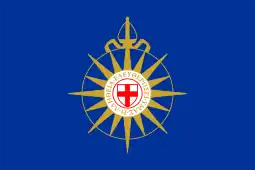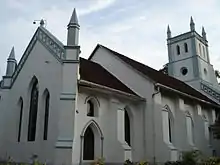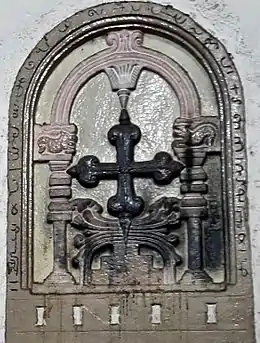Saint Thomas Anglicans
Saint Thomas Anglicans (aka Anglican Syrian Christians or CSI Syrian Christians) are the Saint Thomas Christian members of the Church of South India; the autonomous South Indian province of the Anglican Communion. They are among the several different ecclesiastical communities that splintered out of the once undivided Saint Thomas Christians; an ancient Christian community whose origins goes back to the first century missionary activities of Saint Thomas the Apostle, in the present day South Indian state of Kerala. The Apostle, as legend has it, arrived in Malankara (derived from Maliankara near Muziris) in AD 52.[2][3][4]
| Total population | |
|---|---|
| 152,000 | |
| Regions with significant populations | |
| Kerala, India; with immigrant congregations in Europe, North America and Australia | |
| Languages | |
| Malayalam, English | |
| Religion | |
| Anglicanism | |
| Related ethnic groups | |
| Malayalis, Cochin Jews[1] |
| Part of a series on |
| Christianity in India |
|---|
 |
| Anglican Communion |
|---|
 |
| Part of a series on Anglicanism |
| Organisation |
|
| Theology |
| Liturgy and worship |
| Other topics |
|
|
Origins
In November 1795, a treaty of perpetual friendship and tributary alliance was signed between the Rajah of Travancore and the East India Company. The treaty was again modified in 1805, which established British paramountcy over Travancore.[5][6] The beginning of the relationship between the Anglican Church Mission Society and the ancient Malankara Church could be traced to the Rev R H Kerr and the Rev Claudius Buchanan, who paid visits to the Malabar Syrians in 1806, during the episcopate of Mar Dionysius I.[7][8] The missionaries found the Malabar Syrian Christians in poor and depressed conditions. This is clear in the words of the Syrian Metropolitan Mar Dionysius I, in his interview with Claudius Buchanan, recorded in Dr. Buchanan's famous book "Christian Researches in Asia"; in which Mar Dionysius I says, "you have come to visit a declining church".[9][3][10]
In 1810, Colonel John Munro, a man with deep Christian convictions became the British Resident of Travancore, an office he held for the next 10 years. Col Munro persuaded the Rani of Travancore, with whom he was in very good terms to donate land in Kottayam as well as the money and timber, in-order to build the Orthodox Pazhaya Seminary (founded 1815) for the Malankara Church.[7][11][12][13] He also petitioned the Anglican Church Missionary Society to send missionaries on a Help Mission, to educate and train the clergy of the Malankara Church.[7][11][12][13] In the coming years, several pious Christian men like Benjamin Bailey, Joseph Fenn and Henry Baker (Sr) arrived in Kottayam and worked at the Pazhaya Seminary and among the Malankara Syrians. The missionaries took charge of the college as it early Principals for training the younger Malankara Church clergy and worked on the translation of the Holy Bible to the native language Malayalam.[3][14][7]
However the cordial relations between the missionaries and the Malankara Syrians did not last very long. The younger missionaries who arrived later were uncompromising evangelists who insisted on major reforms to the Malankara Jacobite Church, which the changed Jacobite leadership didn't want. The discord and rifts eventually led to the 1836 Malankara Jacobite Synod of Mavelikkara, in which the Jacobite Syrian Community under Mar Dionysios IV, decided to keep all their Syriac ecclesiastical traditions and be subject to the authority of the Syriac Patriarch of Antioch.[3][14][12] Inevitably, the missionaries and the Malankara Jacobites parted ways and the missionaries continued their work on their own. Nevertheless, the two decades of their association and involvement left a profound and lasting impact on the Malankara Syrian community; calls for reformation were to come from within the Church, later.[3] [15]
In 1836, as soon as the missionaries separated from the Malankara Syrian Church, a minority from the Church who were in favor of the reformed ideologies of the missionaries sought membership in the Anglican Church and were admitted. These St. Thomas Anglicans were the first reformed group to emerge from the St. Thomas Christian community. Initially the Anglican Syrian community was concentrated in the areas of Travancore where the missionaries had earlier worked with the Malankara Syrians.[3][14][8]
British Period
St. Thomas Anglicans benefited from the English education imparted by the missionaries and joined them in their work.[8][3][14] The missionaries were the pioneers who promoted mass education in Travancore and people from all sections of society joined the various schools and the Cotym College established by the Church Mission Society.[16][17][18][19][20] They also started the C.M.S. Press (first printing press of Kerala) in 1821, in Kottayam.[21][22][19] Anglican Syrian Christians served as teachers in the educational institutions and worked in the other institutions established by the Church Mission Society, taking charge of them, later. Some worked along with the missionaries in their evangelical and reformative activities among the poor and backward communities.[16][17][18][19][20] Some served the Government. Several were ordained into priesthood in the Anglican Church and the Anglican Diocese of Travancore and Cochin was established in 1879.[14][23][3][24] St. Thomas Anglicans provided the greater part of the leadership of the Anglican Diocese of Travancore and Cochin.[23][3]
Formation of the Church of South India
During the extensive dialogues that preceded the formation of the Church of South India, the Anglican party while accepting the ministries of all uniting denominations, argued for the introduction of an episcopate in historic succession (from the Anglican Church) into the envisioned United Church, by bestowing episcopal ordinations upon all candidates to bishoprics drawn from non-episcopal traditions.[25][26][27][28][29] They also insisted that all ordinations after the union should be exclusively episcopal, conferred only by existing bishops with the imposition of hands, so that in the fullness of time the entire ministry of the United Church would be in apostolic succession. These were eventually accepted.[25][26][27][28][29] Accordingly on 27 September 1947, as part of the inauguration of the Church of South India, the presiding bishop Rt. Rev. Dr. Cherakarottu Korula Jacob of the Anglican diocese of Travancore and Cochin, along with other Anglican bishops and senior presbyters of the uniting denominations, vested all new candidates to bishoprics with episcopal ordinations.[30] The Church of South India was thus realized and since then the Anglican Syrian Christians came to be known as CSI Syrian Christians.[31][32][33][34]
Anglican Syrian Christians today
After acceding to the CSI, the Anglican Diocese of Travancore and Cochin was renamed as the Madhya Kerala Diocese.[23][24] Although the majority of CSI Syrian Christians have their roots in this diocese, like other Saint Thomas Christian communities, many moved out of Kerala after Indian independence to other Indian states and the rest of the world, starting new congregations.[14][35] Many of these congregations are out side of the South Indian Anglican province and hence fall under the ecclesiastical jurisdiction of the respective provincial bishops, at least technically.[36] Although the cumulative number of Syrian Christians in the South Indian and other Anglican provinces is difficult to determine, it is roughly estimated that they constitute about 4% (approximately 152,000) of the 3.8 million members of the Church of South India.[37][38]
Relations with other Saint Thomas Christians
Due to familial and social ties, Anglican Syrian Christians have always been in cordial relations with the Malankara Syrians and the Jacobite and Orthodox factions that came of it. This continued due to the historic reality that for well over half a century since their split in 1836, the Malankara Church was the only Church that existed in Travancore-Cochin area, from which the Anglican Syrians could get partners in marriage, outside of their own community.[14][39][40] By 1889, the reformists of the Malankara Church separated as an independent Reformed Eastern denomination, choosing the name Mar Thoma Syrian Church in 1898. Since then ecumenical ties have developed with them as well; the Mar Thoma Church is in partnership and full communion with the Church of South India.[15][41]
Gallery

CSI Holy Trinity Cathedral, Kottayam 
CSI Christ Church, Alappuzha 
CSI Christ Church Kodukulanji 
CSI Christ Church, Thiruvananthapuram 
CSI Christ Church, Mavelikara
See also
References
- Ross 1979.
- Gregorios & Roberson 2008, p. 285.
- Neill 2002, pp. 247–249.
- "Anglican Communion: Member Churches".
- Aiya 1906, pp. 389–400.
- Menon 1878, pp. 225–239.
- Tovey 2015.
- "History – CSI Madhya Kerala Diocese". Cite journal requires
|journal=(help) - Buchanan 1811, p. 98.
- Bayly (2004), pp. 281–286.
- Varma.
- McKee 2018.
- Neill 2002, p. 241.
- Chatterton 1924.
- "Heritage – Malankara Mar Thoma Syrian Church". Cite journal requires
|journal=(help) - TH 2016a.
- CMS 2016.
- Mathew 2015, p. 7–8.
- Rajasekharan & Kumar 2003, pp. 5,19,25.
- Menon 1996, pp. 339,348,349.
- Benjamin Bailiyum Malayala Saahityavum. By Dr. Babu Cherian. Published by the Department of Printing and Publishing, Mahatma Gandhi University, Kottayam.
- "The Church Missionary Atlas (India)". Adam Matthew Digital. 1896. pp. 95–156. Retrieved 19 October 2015.
- "Kerala window". www.keralawindow.net.
- "CSI Madhya Kerala – CSI Madhya Kerala Diocese". Cite journal requires
|journal=(help) - Williams 1930.
- Hood 1935.
- Livingstone 2006.
- "The Lambeth Conference and the Union of Churches in South India. --". biblehub.com.
- Douglas 1999.
- "The Order of Service for the Inauguration of Church Union in South India (1947)". anglicanhistory.org.
- "The Order of Service for the Inauguration of Church Union in South India (1947)". anglicanhistory.org.
- ""A Church Is Born" Records, 1947 – 1948 Church of South India Inauguration" (PDF). Cite journal requires
|journal=(help) - "The Church of South India and Reunion in England" (PDF). biblicalstudies.org.uk.
- "The Historic Episcopate IN THE LIGHT OF SOUTH INDIAN EXPERIENCE" (PDF). churchsociety.org.
- "THE SYRIAN CHRISTIANS OF KERALA: DEMOGRAPHIC AND SOCIOECONOMIC TRANSITION IN THE TWENTIETH CENTURY" (PDF). Cite journal requires
|journal=(help) - "What is the Anglican Communion?". Anglican Communion Website.
- "Church of South India — World Council of Churches". www.oikoumene.org.
- "CSI SYNOD". www.csisynod.com.
- "Divisions and Rites of the Churches". Nasranis.
- "Co-operation with the Protestant Churches". mosc.in.
- "Communion of Churches in India". communionofchurchesinindia.org.in.
Sources
- Aiya, V. Nagyam (1906). The Travancore State Manual. Travancore government Press.
- Bayly, Susan (2004). "The collapse of Syrian Christian 'integration'". Saints, Goddesses and Kings: Muslims and Christians in South Indian Society. Cambridge University Press. ISBN 0-521-89103-5.
- Buchanan, Claudius (1811). Christian researches in Asia. Boston: Samuel T. Armstrong. (Christian researches in Asia at the Internet Archive)
- Chatterton, Eyre (1924). "The Diocese of Travancore and Cochin, 1879. The Country of Fiords, Mountains, and Moplahs Bishops". A History of the Church of England in India Since the Early Days of the East India Company. London: SPCK.
- Gregorios, Paulos; Roberson, Ronald G. (2008). "Syrian Orthodox Churches in India". In Fahlbusch, Erwin; Bromiley, Geoffrey William; Lochman, Jan Milic; Mbiti, John; Pelikan, Jaroslav (eds.). The Encyclopedia of Christianity. Wm. B. Eerdmans Publishing. ISBN 9780802824172.
- Hood, Frederic (September 1935). "Some Comments on the South India Scheme". Church Literature Association. Cite journal requires
|journal=(help) - Livingstone, E. A., ed. (2006). "Church of South India". The Concise Oxford Dictionary of the Christian Church. Oxford University Press. ISBN 9780198614425.
- Mathew, E. T. (25 September 1999). "Growth of Literacy in Kerala". Economic and Political Weekly. 34 (39).
- McKee, Gary (6 July 2018). "Benjamin Bailey and the Call for the Conversion of an Ancient Christian Church in India". Studies in World Christianity. 24 (2): 114–134. doi:10.3366/swc.2018.0216. ISSN 1354-9901.
- Menon, Sreedhara (1996). A survey of Kerala History. Madras: S.Viswanathan Printers and Publishers. ISBN 9788126415786.
- Menon, P. Shungoonny (1878). History of Travancore from the Earliest Times. 2. Madras: Higginbotham and Co. ISBN 9788120601697. (History of Travancore from the Earliest Times at the Internet Archive)
- Neill, Stephen (2 May 2002). A History of Christianity in India: 1707–1858. Cambridge University Press. ISBN 978-0-521-89332-9.
- Rajasekharan, G.; Kumar, K. Santhosh, eds. (March 2003). "District Handbooks of Kerala KOTTAYAM" (PDF). DEPARTMENT OF INFORMATION & PUBLIC RELATIONS GOVERNMENT OF KERALA. Archived from the original (PDF) on 19 March 2009. Cite journal requires
|journal=(help) - Ross, Israel J. (1979). "Ritual and Music in South India: Syrian Christian Liturgical Music in Kerala". Asian Music. 11 (1): 80–98. doi:10.2307/833968. JSTOR 833968.
- "Missionaries led State to renaissance: Pinarayi". The Hindu. 13 November 2016.
- Tovey, Phillip (7 January 2015). "Colonel John Munro Evangelical Christian". Kerala History. academia.edu.
- Varma, Kocha. "John Munro". History of Cochin Royal Family.
- Williams, N. P. (1930). Lausanne, Lambeth and South India. London: Longmans, Green, & Co.
- "Kerala to celebrate CMS mission" (Press release). Church Mission Society. 9 November 2016.
- Douglas, Ian T. (14 September 1999). "Church of South India Contributes to Anglican Communion" (Press release). Anglican Communion News Service.
Further reading
- Frykenberg, Robert Eric (2017). "Espiscopal establishment in India to 1914". In Milton, Anthony; Strong, Rowan; Gregory, Jeremy; Morris, Jeremy N.; Sachs, William L. (eds.). The Oxford History of Anglicanism. 3. Oxford University Press. pp. 302–303. ISBN 9780199699704.
- Frykenberg, Robert Eric (2008). "Missionaries, Colonialism, and Ecclesiastical Dominion". Christianity in India: From Beginnings to the Present. Oxford History of the Christian Church. Oxford University Press. ISBN 9780198263777.
- Thomas, Anthony Korah (1993). "Anglican (Syrian) Christians in the 19th and 20th Centuries". The Christians of Kerala: A Brief Profile of All Major Churches. Kottayam.
